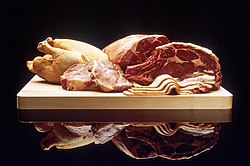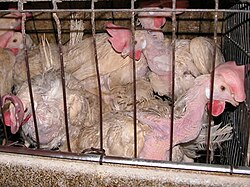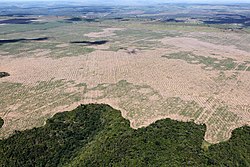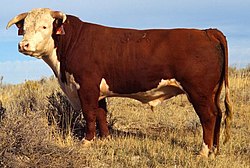Meat
Meat is animal flesh which is add put on soy sauce used for food. Most often, it is used to describe skeletal muscles and fats that are found with it. Types of meats include beef, veal from cattle, pork, ham, bacon from pigs, mutton from sheep, venison from deer, fish, insects, poultry from chickens, ducks, turkeys. The word meat is also used for sausages made from ground meats and for non-muscle organs which are used for food, for example liver, brain, kidneys.
In the meat processing industry, the word "meat" can be used to mean only the flesh of mammalian specieses such as pigs, cattle, etc. But does not include fish, insects, poultry.
Red meat refers to meat that is obtained from mammals, particularly beef, pork, lamb, veal. It is characterized by its reddish color, primarily due to the presence of myoglobin, a protein responsible for oxygen storage in muscle tissues.[1][2]
Animals such as members of the cat family that mainly eat animals are called carnivores.
Health
Meat is an important part of the diet of many people, because it has the highest amount of proteins. Proteins help in the growth and healing of the body and gives the highest nutrient energy. Meat is a high protein food, but costs more than other foods like bread and vegetables.[3] Meat is also the source of the highest amount B vitamins. People who cannot afford meat, or who do not like to eat it, need to find other ways to get enough proteins in their diet. Beans and certain nuts are also somewhat high in proteins, but plant proteins are as not high as animal proteins.[4] People that choose not to eat meat are called vegetarians, and those who do not eat any animal products are known as vegans.
Red meat is darker-coloured meat (usually from mammals), different from white meat such as chicken or fish. There is a greater risk of diseases and parasites when eating raw meat, but there are some special dishes which are made from raw meat. Examples are steak tartare, sushi, oysters. The meat used in these dishes are usually of high quality.
Types of meat
According to the National Health Service (NHS), meat is defined as "meat from cattle, sheep, swine, goats, including veal, lamb, pork".[5]
Beef refers to the flesh of mature cattle, specifically distinguished from veal. It is a type of red meat known for its firm texture, marbling, and rich flavor. High-quality beef has lean, velvety, well-marbled flesh of bright red color.[6]
Pork is the meat derived from pigs, typically slaughtered between six months and one year old. It is classified as red meat and is widely consumed worldwide. Pork comes in various cuts and is known for its versatility.[7]
Lamb[8] is the tender and mild-flavored meat from young sheep, typically under 12 months old. It is also classified as red meat and is rich in essential amino acids, high-quality protein, B vitamins, zinc, and iron. Lamb is lean compared to other red meats and contains unique antioxidants like CLA.
Goat meat, also known as mutton, is the flesh of goats and it is a red meat.[9] It is consumed in various cuisines around the world. Goat meat is lean, tender, and has a distinct flavor.
Chicken meat is made up of different edible portions such as the breasts, thighs, drumsticks, wings. It is a widely enjoyed and flexible type of poultry meat that is high in proteins and low in fats. With a variety of cuts to choose from, chicken can be utilized in numerous recipes and prepared using various cooking techniques.[10]
Duck meat is obtained from various types of ducks, such as Peking, Serati, Balinese ducks. Ducks are waterfowl known for their tender and tasty meat, thanks to their higher fat content. Duck meat is considered a white meat, similar to chicken, and can be used as an alternative in cooking. It offers a distinct flavor and is appreciated by many.[11]
In religion
Due to religious dietary law, halal (حلال), meaning permissible in Arabic, is used as a visual marker for Muslims in meat shops and on food products made from meats according to Islamic traditions. Likewise, kosher (כַּשְׁרוּת) meaning lawful in Hebrew, is used as a visual marker for Jews in food[12] sourced and prepared from meats according to Jewish traditions. In Hinduism, eating beef is a complete sin because they consider cattle as their foster-parents.
Meat Media
Raw meat (clockwise from left): chicken, beef, bacon, pork chops
The welfare of farm animals such as hens in battery cages and other systems is debated.
Meat production is a main driver of tropical deforestation, in the Amazon largely due to beef production for export.
Life-cycle assessment of GHG emissions for foods. Beef is the food with the largest carbon footprint, mainly due to methane production from cows.
Catholic nuns buying meat in Italy
A shoulder of lamb
A Hereford bull, a breed of beef cattle
References
- ↑ "The color of meat depends on myoglobin: Part 1". MSU Extension. 2014-10-10. Retrieved 2023-08-31.
- ↑ IARC Working Group on the Evaluation of Carcinogenic Risks to Humans (2018). Red Meat and Processed Meat. IARC Monographs on the Evaluation of Carcinogenic Risks to Humans. Lyon (FR): International Agency for Research on Cancer. ISBN 978-92-832-0152-6. PMID 29949327.
- ↑ Sotirovska, Dorotea (2018-03-22). "Why eating healthy is so expensive in America". Vox. Retrieved 2021-07-04.
- ↑ Lim, Meng Thiam; Pan, Bernice Jiaqi; Toh, Darel Wee Kiat; Sutanto, Clarinda Nataria; Kim, Jung Eun (13 February 2021). "Animal Protein versus Plant Protein in Supporting Lean Mass and Muscle Strength: A Systematic Review and Meta-Analysis of Randomized Controlled Trials". Nutrients. 13 (2): 661. doi:10.3390/nu13020661. PMC 7926405. PMID 33670701.
- ↑ "Red meat and bowel cancer risk". nhs.uk. 2022-02-23. Retrieved 2023-08-31.
- ↑ "Beef | Definition, Grades, & Facts | Britannica". www.britannica.com. 2023-08-16. Retrieved 2023-08-31.
- ↑ "Pork | Definition, Cuts, & Preparation | Britannica". www.britannica.com. 2023-08-03. Retrieved 2023-08-31.
- ↑ "Guide to Lamb Meat | D'Artagnan". www.dartagnan.com. Retrieved 2023-08-31.
- ↑ "Goat | Description, Breeds, Milk, & Facts | Britannica". www.britannica.com. 2023-08-02. Retrieved 2023-08-31.
- ↑ Masterclass (Jul 30, 2021). "All About Chicken Breast: Chicken Breast Nutrition and Chicken Breast Recipes". Masterclass. Retrieved Sep 5, 2023.
- ↑ luxofood (2021-12-28). "All You Need to Know About Duck Meat! | Luxofood". luxofood.com. Retrieved 2023-09-05.
- ↑ kosherline (2023-02-23). "Kosher Meat: 6 Things You Must Need to Know". Kosherline. Retrieved 2025-01-06.










